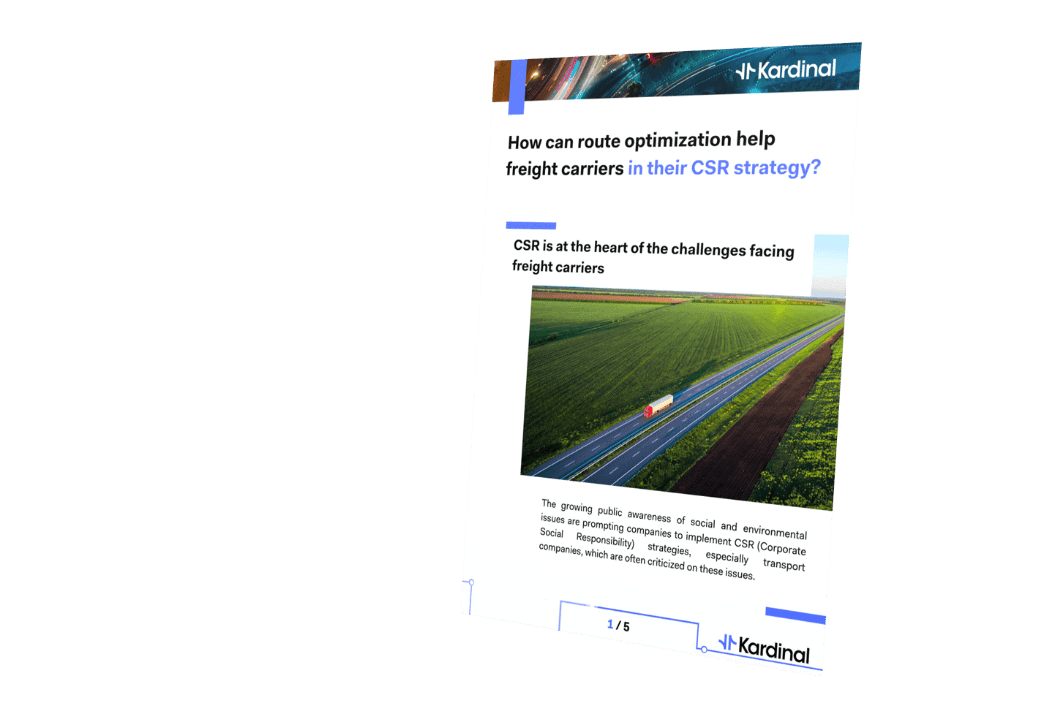[REPORT]
How can route optimization help
freight carriers in their CSR strategy?
As the recent FNTR campaign reminds us, 89% of goods are transported by road.
Behind the slogan “If you have it, it’s because a truck brought it to you”, the federation points out the daily service provided by road transport, an essential component of our economy.
The industry is known to contribute to climate change through the emission of greenhouse gases and other harmful pollutants, due to the nature and scale of its activities. According to Citepa (Centre Interprofessionnel Technique d’Etudes de la Pollution Atmosphérique), in France, trucks are responsible for about 8% of CO2 emissions.
At a time of increased environmental awareness and the fight against climate change, the freight transport industry is working to reduce its fuel consumption. Many carriers have decided to take part in the global ecological effort by joining the ADEME’s CO2 Charter initiative.
How can logistics operations be optimized to reduce their environmental impact? What specific solutions can carriers use?
Carriers, what can you do?
Businesses in the road freight transport industry that are committed to reducing their CO2 emissions are changing their vehicles and technologies as well as their practices (organizational and behavioral) to reach their objectives.
The “Charter of Voluntary Commitments to Reduce CO2 Emissions from Road Freight Transport”, drafted by the French Ministry of Ecological Transition and Solidarity (MTES) and the French Agency for the Environment and Energy Management (ADEME), shares guidelines to take action. In this article, we will look at some of them.
PART 1: Upgrading vehicle fleets and driving practices
Fleet modernization and technical optimization of vehicles
There are many ways to reduce fuel consumption by modernizing or technically adapting current vehicle fleets. The first solution is to improve the horsepower of the vehicles when renewed. In France, the average truck power is currently around 450 HP and is increasing every year as it provides safety and comfort for drivers. However, it is estimated that for trucks, a decrease of 50-80 HP would allow savings of about 5%-10% in fuel consumption. Taking into account the type of work the vehicle will be doing (urban or long distance, hilly or flat, “heavy” or ” bulky” transport, etc.), it is recommended that carriers discuss with the different manufacturers to choose the most suitable engine power for the specific nature of the carrier’s activities and the vehicle’s purpose.
Since 1988, Euro standards have set maximum limits for harmful emissions (nitrogen oxides (NOx), carbon monoxide (CO), hydrocarbons (HC) and particles) for new vehicles. The current standard is Euro VI (or 6): it is 5 times more restrictive than the previous one (Euro V or 5) on nitrogen oxides, 3 times more for hydrocarbons and 2 times more for particles. Today, 57% of trucks on the road are Euro VI compliant. The renewal to this type of truck is an effective way of improving the environmental impact of carriers (all the more as the retiring vehicles are old). This initiative is also consistent with the implementation of Low Emission Zones by cities to reduce pollution in urban areas.
NOTE: The term “Low Emission Zone” has replaced the previous term used until the end of 2019, “Restricted Traffic Zone”. A Low Emission Zone is an urban area where access is restricted to the most polluting vehicles. In France, restrictions are based on “Crit’Air” stickers (air quality certificates). This system was introduced under the Law on Energy Transition for Green Growth of August 17, 2015 and is included in the draft law on mobility (LOM). In 2024, the city of Paris will ban Crit’Air vehicles above 2, thus banning diesel cars and eliminating the most polluting emissions in the French capital.
Lastly, technical adjustments to vehicles can help reduce fuel consumption: for example, limiting the maximum speed of vehicles (for long journeys), automatic engine shutdown when idling (for journeys with many long stops), or intelligent cruise control (very useful on hilly roads). Other areas of optimization include vehicle weight reduction, tire maintenance and axle optimization.
Use of electric vehicles
Electric trucks are gradually arriving on the French market. For utility vehicles, there are already a number of electric vehicles available, but the offer dwindles as the size of the vehicles increases and is still in its infancy for long-distance trucks.
The range of vehicles, the availability of charging infrastructure and charging times are criteria that are still holding back the deployment of electric vehicles, as is the additional cost of purchase, which is much higher than for a diesel vehicle of the same type. A long-term return on investment is therefore required and priority should be given to the replacement of vehicles dedicated to urban deliveries.
In terms of CO2 emissions reduction, the savings from replacing a fossil fuel vehicle with an electric vehicle are around 95% for a fully electric vehicle.
NOTE: Volvo Trucks (and its subsidiary Renault Trucks) have announced plans to market 16- to 19-ton vehicles for urban delivery with a range of 300 km. Mercedes has also announced multi-billion dollar investments in the development of electric vehicles from 2021. Nikola Motors is promising a new type of battery with a range of 1300 km! Finally, Tesla’s are also in the news with projects for vehicles with impressive performances!
The use of Natural Gas Vehicles (NGV)
During the same conference, we learnt that the company Bils-Deroo has decided to renew part of its fleet with trucks running on CNG. With 3 trucks to start with, Jimmy Bils (CEO of Bils-Deroo) estimates that his fleet will be made up of 10 trucks using this type of fuel before the end of 2020.
Although the incentives are less attractive than those for electric vehicles, there are subsidies for the purchase of gas-powered vehicles in France. In Germany, the parliament recently voted to extend the exemption from tolls for CNG trucks until 2023.
Despite this, the extra cost of buying a gas truck is very high, up to 30% more than a conventional truck. Maintenance is also more expensive and the truck’s downtime is longer and more frequent. The cost saving is about 15-20% compared to conventional fuels. Depreciation is done over time, the initiative is more eco-friendly than economical: less CO2 emissions, noise reduction (2 to 3 times less noise depending on the type of vehicle) and reduced odor annoyances for local residents. CNG vehicles are also Crit’Air 1 classified and therefore have access to Low Emission Zones introduced in some urban areas in France.
The CNG refueling network is still limited on the French territory: the expansion of the network is an important step for the growth of this technology. The rollout of CNG stations is continuing at a steady pace in France with 228 stations planned for June 2021 (+58% compared to June 2020). To overcome this, some carriers have invested in private or shared stations.
NOTE: Bio-NGV is the renewable version of CNG: the methane used is produced from renewable resources (organic waste from households, industry and farms) and no longer from fossil resources. Therefore, no CO2 emissions are caused by its use, making it part of the circular economy.
Energy-efficient driving
Energy-efficient driving is an important element in reducing fuel consumption and emissions. Since peak emissions occur during acceleration phases, reducing aggressive driving and adopting proactive driving habits can reduce NOX, PM and VOC emissions, depending on the vehicle and the driving style adopted previously. The benefits of energy-efficient driving can also lead to fewer road accidents, less noise pollution and less wear and tear on brakes and tires.
After initial training on energy-efficient driving, the average fuel consumption of a truck is reduced by about 5.25 l/100 km. However, these savings tend to fade over time, making regular training sessions necessary.
As a result of energy-efficient driving training sessions and the conversion of its entire fleet to Euro VI, Bils Deroo now has an average fuel consumption of 28L/100km, compared to 45L/100km in 1986.

